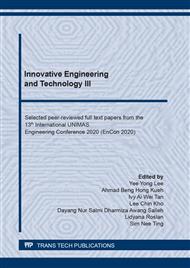[1]
S.K.A. Niharika Mohanta, Investigation of mechanical properties of luffa cylindrica fibre reinforced epoxy hybrid composite,, (in English), vol. 7, pp.1-10, 2015, doi: http://dx.doi.org/10.4314/ijest.v7i1.1. MultiCraft.
DOI: 10.15376/biores.10.4.8364-8377
Google Scholar
[2]
H. W. Sha Yin, Jiani Li, Robert O. Ritchie, Jun Xu, Light but tough bio-inherited materials: Luffa sponge based nickel-plated composites,, (in English), vol. 94, pp.10-18, 2019, doi: https://doi.org/10.1016/j.jmbbm.2019.02.029. Elsevier.
DOI: 10.1016/j.jmbbm.2019.02.029
Google Scholar
[3]
T. H. D. S. Valcineide O.A. Tanobe, Marilda Munaro, Sandro C. Amico, A comprehensive characterization of chemically treated Brazilian sponge-gourds (Luffa cylindrica),, (in English), vol. 24, pp.474-482, 2005, doi:.
DOI: 10.1016/j.polymertesting.2004.12.004
Google Scholar
[4]
S. K. Saw, Effect of stacking patterns on morphological and mechanical properties of luffa/coir hybrid fiber-reinforced epoxy composite laminates,, in Hybrid Polymer Composite Materials Structure and Chemistry, vol. 1, M. K. T. Vijay Kumar Thakur, Raju Kumar Gupta Ed.: Woodhead Publishing, 2017, ch. 356, pp.313-333. Elsevier.
DOI: 10.1016/b978-0-08-100791-4.00012-4
Google Scholar
[5]
Q. L. Shouzheng Su, Jingyuan Liu, Hongsen Zhang, Rumin Li, Xiaoyan Jing, Jun Wang, Polyethyleneimine-functionalized Luffa cylindrica for efficient uranium extraction,, (in English), vol. 530, pp.538-546, 2018, doi: https://doi.org/10.1016/j.jcis.2018.03.102. Elsevier.
DOI: 10.1016/j.jcis.2018.03.102
Google Scholar
[6]
D. D. a. B. H. Mizi Fan, Fourier Transform Infrared Spectroscopy for Natural Fibres,, in Fourier Transform - Material Analysis, D. S. Salih, Ed.: InTech, 2012, ch. 3, pp.45-68.
DOI: 10.5772/35482
Google Scholar
[7]
M. B. Arun Kumar Gupta, S. Mohanty, and S. K. Nayak, Mechanical, Thermal Degradation, and Flammability Studies on Surface Modified Sisal Fiber Reinforced Recycled Polypropylene Composites,, (in English), vol. 2012, pp.1-13, 12 November 2012 2012. Hindawi Publishing Corporation Advances in Mechanical Engineering.
DOI: 10.1155/2012/418031
Google Scholar
[8]
A. Dutta, Fourier Transform Infrared Spectroscopy,, Elsevier, 2017, ch. 4, pp.73-93. Elsevier.
Google Scholar
[9]
S. C. D. C. Parida, S.K. Dash, Mechanical Analysis of Bio Nanocomposite Prepared from Luffa cylindrica,, (in English), vol. 4, pp.53-59, 2012,.
DOI: 10.1016/j.proche.2012.06.008
Google Scholar
[10]
J. H. F. a. L. A. Wall, General Treatment of the Thermogravimetry of Polymers,, (in English), vol. 70A, pp.1-37, (1966).
Google Scholar
[11]
R. P. Sudhir Kumar Saw, Sourabh Nandy, Joyjeet Ghose, and Gautam Sarkhel, Fabrication, Characterization, and Evaluation of Luffa cylindrica Fiber Reinforced Epoxy Composites,, (in English), vol. 8, pp.4805-4826, 2013. bioresources.
DOI: 10.15376/biores.8.4.4805-4826
Google Scholar
[12]
J. T. Kaewta Kaewtatip, Studies on the structure and properties of thermoplastic starch/luffa fiber composites,, (in English), vol. 40, pp.314-318, 2012, doi: http://dx.doi.org/10.1016/j.matdes.2012.03.053. Elsevier.
DOI: 10.1016/j.matdes.2012.03.053
Google Scholar
[13]
L. G. T. a. S. P. Xue Li, Chemical Treatments of Natural Fiber for Use in Natural Fiber-Reinforced Composites: A Review,, (in English), vol. 15, pp.25-33, 2007,.
DOI: 10.1007/s10924-006-0042-3
Google Scholar
[14]
S. M. L. Ghali, M. Zidi, F. Sakli, Effect of pre-treatment of Luffa fibres on the structural properties,, (in English), vol. 63, pp.61-63, 2009, doi:.
DOI: 10.1016/j.matlet.2008.09.008
Google Scholar
[15]
K. K. N. Karthi, S. Sathish, S. Gokulkumar, L. Prabhu, N. Vigneshkumar, An overview: Natural fiber reinforced hybrid composites, chemical treatments and application areas,, (in English), vol. 27, pp.2828-2834, 2020, doi: https://doi.org/10.1016/j.matpr.2020.01.011. Elsevier.
DOI: 10.1016/j.matpr.2020.01.011
Google Scholar
[16]
M. M. V. Vilay, R. Mat Taib, Mitsugu Todo, Effect of fiber surface treatment and fiber loading on the properties of bagasse fiber–reinforced unsaturated polyester composites,, (in English), vol. 68, pp.631-638, 2008,.
DOI: 10.1016/j.compscitech.2007.10.005
Google Scholar
[17]
A. B. Sherely Annie Paul, Laurent Ibos, Yves Candau, Kuruvilla Joseph, Sabu Thomas, Effect of fiber loading and chemical treatments on thermophysical properties of banana fiber/polypropylene commingled composite materials,, (in English), vol. 39, pp.1582-1588, 2008,.
DOI: 10.1016/j.compositesa.2008.06.004
Google Scholar
[18]
A. V.-G. l. P.J. Herrera-Franco, A study of the mechanical properties of short natural-fiber reinforced composites,, (in English), vol. 36, pp.597-608, 2005,.
DOI: 10.1016/j.compositesb.2005.04.001
Google Scholar
[19]
P. K. K. a. R. Kumar, Effect of Silanes on Mechanical Properties of Bamboo Fiber-epoxy Composites,, (in English), vol. 29, pp.1-10, 2010,.
Google Scholar
[20]
M. S. L. H. M. Hamideh Hajiha, Modification and Characterization of Hemp and Sisal Fibers,, (in English), vol. 11, pp.144-168, 2014,.
Google Scholar
[21]
S. S. G. Mukesh Effect of chemical modification of fiber surface on natural fiber composites: A review,, (in English), vol. 18, pp.3428-3434, 2019. Elsevier.
DOI: 10.1016/j.matpr.2019.07.270
Google Scholar
[22]
J. P. P. a. P. H. Parsania, Biodegradable and Biocompatible Polymer Composites,, in Characterization, testing, and reinforcing materials of biodegradable composites: Elsevier, 2018, ch. 55-79, p.438.
DOI: 10.1016/b978-0-08-100970-3.00003-1
Google Scholar
[23]
P. S. S. L. Boopathi, K. Mylsamy, Investigation of physical, chemical and mechanical properties of raw and alkali treated Borassus fruit fiber,, (in English), vol. 43, pp.3044-3052, 2012, doi: http://dx.doi.org/10.1016/j.compositesb.2012.05.002. Elsevier.
DOI: 10.1016/j.compositesb.2012.05.002
Google Scholar
[24]
A. D. a. M. D. M. S. N. Pandey, Thermal Analysis of Chemically Treated Jute Fibers,, (in English), vol. 3, pp.143-150, (1993).
Google Scholar


